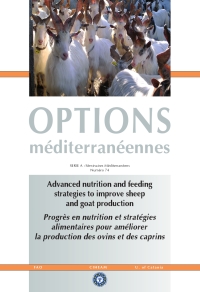| Article précédent | p. 141-145 | Article suivant |
Effect of the ratio between non-structural carbohydrates and degradable protein of concentrate on milk yield and quality of grazing Cilentana goats
Forty-five Cilentana goats were equally divided into three groups that received, as pasture supplementation, three concentrates with a different NSC:degradable protein ratio: 0.84, 0.73 and 0.60, respectively for groups A, B and C. The concentrates were fed at 200, 300 and 400 g/head/d, and at 45, 30 and 15 days before lambing, respectively. Then, the quantities increased until 800 g/head/d. After two months from lambing, the lambs were sold; the milk yield was monitored monthly for 5 controls. Each time, individual milk samples were collected and analysed for protein, fat, lactose, non-protein nitrogen and casein. Group A showed significantly higher milk yields, averaged over the whole trial period (1.463 vs 1.343 vs 1.182 kg/d, respectively for groups A, B and C; P<0.01) and a lower non-protein nitrogen percentage (0.21 vs 0.24 and 0.23, respectively for groups A, B and C; P<0.01).
Quarante-cinq chèvres Cilentana ont été également divisées en trois groupes recevant, comme supplémentation du pâturage, trois concentrés ayant différents rapports NSC/protéines dégradables : 0,84, 0,73 et 0,60, respectivement pour les groupes A, B et C. Les concentrés étaient distribués à raison de 200, 300 et 400 g/tête/j, et à 45, 30 et 15 jours avant l'agnelage, respectivement. Ensuite, les quantités augmentaient jusqu'à 800 g/tête/j. Deux mois après l'agnelage, les agneaux étaient vendus ; la production de lait était suivie mensuellement pendant 5 contrôles. Chaque fois, des échantillons individuels de lait étaient prélevés et analysés pour connaître les protéines, matière grasse, lactose, azote non protéique et caséine. Le groupe A montrait des productions de lait significativement supérieures, d'après la moyenne calculée sur toute la période de l'essai (1,463 vs 1,343 vs 1,182 kg/j, respectivement pour les groupes A, B et C ; P<0,01) et un pourcentage plus faible en azote non protéique (0,21 vs 0,24 et 0,23, respectivement pour les groupes A, B et C ; P<0,01).
- [ Afficher ]
- [ Télécharger ]
- [ Exporter la citation ]
Vous pouvez télécharger la citation au format :
- [ Imprimer ]
-
Mots-clés
ACIDE GRAS, ACIDE GRAS POLYINSATURE, CHEVRE, COMPLEMENT ALIMENTAIRE, EXPERIMENTATION, LACTOSE, LAIT, PRODUCTION LAITIERE, QUALITE, REGIME ALIMENTAIRE, UREECiter cet article
Grossi M., Bovera F., Piccolo V., D'Urso S., Cutrignelli M.I., Infascelli F. Effect of the ratio between non-structural carbohydrates and degradable protein of concentrate on milk yield and quality of grazing Cilentana goats. In : Priolo A. (ed.), Biondi L. (ed.), Ben Salem H. (ed.), Morand-Fehr P. (ed.). Advanced nutrition and feeding strategies to improve sheep and goat . Zaragoza : CIHEAM, 2007. p. 141-145. (Options Méditerranéennes : Série A. Séminaires Méditerranéens; n. 74). 11. Seminar of the FAO-CIHEAM Sub-Network on Sheep and Goat Nutrition, 2005/09/08-10, Catania (Italy). http://om.ciheam.org/om/pdf/a74/00800369.pdf



